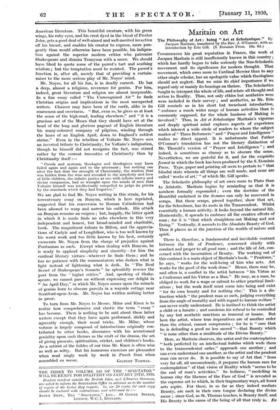Maritain on Art
The Philosophy of Art : being " Art et Scholastique." By Jacques Maritain, translated by the Rev. J. O'Connor, with an CONSIDERING his great reputation in France, the work of Jacques Maritain is still insufficiently known in this country ; which has hardly begun to take seriously the Neo-Scholastic movement and its significance for modern thought. That movement, which owes more to Cardinal Mercier than to any other single scholar, has an apologetic value which theologians should not neglect. But we miss its chief importance if we regard only or mainly its bearings on theism. ' The Scholastics sought to interpret the whole of life, and relate all thought and action to Reality. Thus, not only ethics but aesthetics were were included in their survey ; and aesthetics, as Mr. Eric Gill reminds us in his short but trenchant introduction, " embrace a much wider range of human activities than is commonly supposed, for the whole business of Making is involved." Thus, in Art et Scholastique Maritain's vigorous and deeply spiritual mind explores aspects of experience which interest a wide circle of readers to whom the subject matter of " Three Reformers " and " Prayer and Intelligence " makes no direct appeal. It is unfortunate that Father O'Connor's translation has not the literary distinction of Mr. Thorold's version of " Prayer and Intelligence " ; and indeed, is sometimes so clumsy as to obscure the sense. Nevertheless, we are grateful for it, and for the exquisite format in which the book has been produced by the S. Dominic Press. Type, paper and printing all seem to pertain to " that blissful state wherein all things are well made, and none are called ` works of art,' " of which Mr. Gill speaks.
The Scholastic philosophy of art owes more to Plato than to Aristotle. Maritain begins by reminding us that it is nowhere formally expounded ; even the doctrine of the Beautiful enshrined in the Summa can only be recovered in scraps. But these scraps, pieced together, show that art, for the Schoolmen, has its roots in the Transcendent. Whilst essentially a human activity, it looks beyond the natural life. Horizontally, it spreads to embrace all the creative efforts • of man ; for it is "that which straightens out Making and not Doing." Vertically, it ascends to the Absolute Beauty of God. Thus it places us at the junction of the worlds of nature and spirit.
There is, therefore, a fundamental and inevitable contrast between the life of Prudence, concerned chiefly with conduct and proper to all good men ; and the life of Art, con- cerned with the incarnation of Beauty. The working out of this contrast is a main object of Maritain's book. " Prudence," he says, " works for the well-being of him who acts. Art works for the good of the work done." Hence, there may be, and often is, a conflict in the artist between " his Virtue as a Craftsman and his Virtue as a Man:' He may, as a man, be obliged to work for a wage or submit to other practical limit- ations ; but the work itself must come into being and exist " for its own beauty and for nothing else." This is a dis- tinction which " the prudent man as such, judging everything from the angle of morality and with regard to human welfare " can never really understand. He is inclined to think the artist a child or a lunatic ; and condemn his refusal to be controlled by any but aesthetic sanctions as immoral or insane. But here the artist, whose true imperatives are of another order than the ethical, cannot compromise ; for he is " sure that he is defending a good- no less sacred "—that Beauty which " is none other than a similitude of the Divine Beauty."
Here, as Maritain observes, the artist and the contemplative " both perfected by an intellectual habitue which weds them to the transcendental order," approach one another ; and can even understand one another, as the artist and the prudent man can never do. It is possible to say of Art that " from very far off, all unconsciously, it prepares the human race for contemplation" of that vision' of Reality which "seems to be the end of man's activities." So holiness, " modelling in human clay the likeness of the Face of God " is revealed as the supreme art to which, in their fragmentary ways, all lesser arts aspire. For these, in so far as they indeed mediate Beauty, are each in their own tongue declaring the divine name ; since God, as St. Thoinis teaches, is Beauty itself, and His Beauty is the cause of the being of all thit truly is. Ex
divina pulchritudine esse ontniuni derivatur. In so far, then, as he incarnates beauty, that confidential message of the divine, the artist may claim the great title of fellow-worker
with God. EVELYN UNDERHILL.







































 Previous page
Previous page